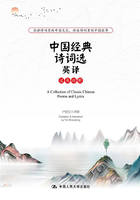
第2章 国风·周南·关雎
先秦:佚名
关关雎鸠,
在河之洲。
窈窕淑女,
君子好逑。
参差荇菜,
左右流之。
窈窕淑女,
寤寐求之。
求之不得,
寤寐思服。
悠哉悠哉,
辗转反侧。
参差荇菜,
左右采之。
窈窕淑女,
琴瑟友之。
参差荇菜,
左右芼之。
窈窕淑女,
钟鼓乐之。
1.Folk Songs·A Folk Song from the Southern Region Under the Rule of the Duke of Zhou·The Courting White-breasted Waterhen
The Pre-Qin Period: Anonymous
"Kwak-kwak" courts the white-breasted waterhen
On the islet of the river;
A gentle and graceful maiden
Is a gentleman's good partner.
Water poppies of length uneven,
From left to right, I try to fish for;
A gentle and graceful maiden,
Awake or asleep, I really adore.
I cannot win the heart of my goddess;
Day and night, she is on my mind.
O, I am restless, I am restless;
I toss and turn in bed for love blind.
Water poppies of length uneven,
From left to right, I try to pluck;
A gentle and graceful maiden,
I play the qin[2] or the se[3] to befriend to try my luck.
Water poppies of length uneven,
From left to right, I try to pull out;
A gentle and graceful maiden,
I play bells or drums to tease her out.
作者简介
《诗经》是中国最早的诗歌总集,据传为尹吉甫采集、孔子编订,反映了西周初年至春秋中叶(公元前11世纪-公元前6世纪)的社会生活,绝大部分诗文作者不可考。《诗经》被认为是中国现实主义诗歌的源头,共311篇,其中《风》160篇,《雅》105篇,《颂》40篇,其余6篇仅剩标题,无内容,称为笙诗。
《风》多为民间歌谣,主题涉及爱情、婚姻、农事、政治、战争等;《雅》为上层社会典礼、宴会演唱歌曲;《颂》为祭祀、祈祷、祝颂祖先神灵之诗。
《国风·周南·关雎》是中国文学开篇之作,一般认为是男女情歌。此诗以雎鸠之鸣“起兴”,即“先言他物以引起所咏之辞”(朱熹),以采荇菜的动作变化来体现男子对女子的热烈追求。
“雎鸠”到底为何种鸟?历来众说纷纭;有考证认为,“雎鸠”今为“白腹秧鸡”,本诗选译文采此说!
《国风·秦风·蒹葭》勾勒出一幅“可望不可即”的人生画面和艺术意境。此诗寓意深刻,语言简练,节奏明快,双声叠韵,婉转动人。
有观点认为,此诗意在讥刺秦襄公未能以周礼治理国家,或惋惜招引隐士而不得。现代学者多认为《蒹葭》为爱情诗。
蒹:没长穗芦苇;长穗芦苇为萑(huán);葭:初生芦苇。